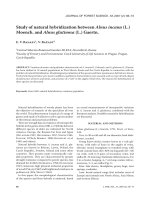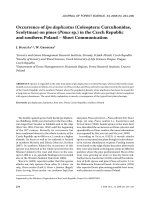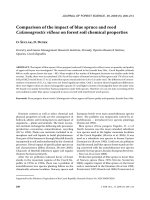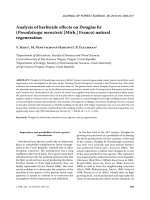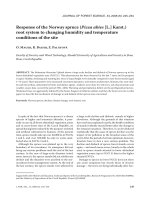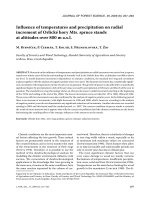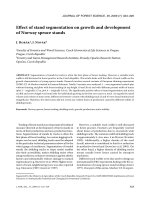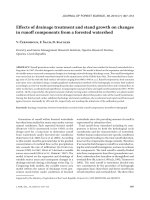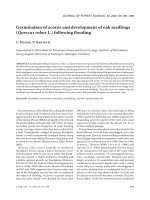Báo cáo lâm nghiệp: "Influence of flooding on growth, nitrogen availability in soil, and nitrate reduction of young oak seedlings (Quercus robur L.)" docx
Bạn đang xem bản rút gọn của tài liệu. Xem và tải ngay bản đầy đủ của tài liệu tại đây (276.96 KB, 8 trang )
593
Ann. For. Sci. 62 (2005) 593–600
© INRA, EDP Sciences, 2005
DOI: 10.1051/forest:2005052
Original article
Influence of flooding on growth, nitrogen availability in soil,
and nitrate reduction of young oak seedlings (Quercus robur L.)
Badr ALAOUI-SOSSÉ*, Bastien GÉRARD, Philippe BINET, Marie-Laure TOUSSAINT, Pierre-Marie BADOT
Université de Franche-Comté – INRA, Laboratoire de Biologie Environnementale, BP 71427, 4 place Tharradin, 25211 Montbéliard Cedex, France
(Received 4 March 2004; accepted 28 January 2005)
Abstract – Oak (Quercus robur L.) seedlings were grown in pots under controlled conditions and submitted to 34 days of flooding followed
by two-week drainage. Roots were significantly affected with reduced extension and dry weight accumulation. After drainage, biomass
production of adventitious roots markedly increased in flooded seedlings. Flooding induced a sharp decrease in NO
3
–
-N content in the soil
especially in the bottom of pots. NH
4
+
-N concentrations increased significantly but at less level compared to NO
3
–
-N decreases. During
flooding, root nitrate reductase activity (NRA) was similar to controls while leaf NRA was always below that of controls. The flooded roots
maintained amino acid synthesis despite the nitrate depletion in soil. By contrast, leaf amino acid content decreased significantly in flooded
seedlings especially at day 34. In flooded seedlings, the transfer of amino acid from cotyledons was disrupted but the transfer capacity was
restored after drainage. Relationships between nitrate reduction and changes in soil mineral nitrogen availability are discussed.
flooding / mineral nitrogen availability
/ nitrate reduction / Quercus robur L.
Résumé – Influence de l’ennoyage sur la croissance, la biodisponibilité en azote du sol, et sur la réduction des nitrates chez de jeunes
semis de chêne pédonculé (Quercus robur L.). Des semis de chêne pédonculé (Quercus robur L.) cultivés en conditions contrôlées ont été
soumis à 34 jours d’ennoyage suivi de deux semaines de drainage. La longueur des racines stressées ainsi que leur accumulation de biomasse
ont été significativement réduites. Après drainage, la biomasse des racines adventives des semis ennoyés a fortement augmenté. L’ennoyage a
induit une forte diminution des teneurs en N-NO
3
–
dans le sol, particulièrement dans les 5 cm inférieurs du pot. La concentration en N-NH
4
+
a
augmenté significativement mais sans compenser la diminution de N-NO
3
–
. Pendant l’ennoyage, les activités nitrate réductase racinaires des
deux lots étaient similaires alors que dans les feuilles elle était toujours inférieure chez les plants ennoyés. Les racines ennoyées ont maintenu
la synthèse d’acides aminés malgré la disparition des nitrates dans le sol. Au contraire, la teneur en acides aminés dans les feuilles avait
significativement diminué dans les semis ennoyés en particulier à 34 jours. Dans les semis ennoyés, le transfert des acides aminés depuis les
cotylédons était perturbé, cependant après drainage la capacité de transfert était rétablie. Les relations entre la réduction des nitrates et les
changements de la biodisponibilité de l’azote minéral du sol sont discutées.
ennoyage / azote minéral disponible / réduction des nitrates / Quercus robur L.
1. INTRODUCTION
Flooding is characterised by a temporary or a permanent sat-
uration of soil pores with water. This reduces drastically gas dif-
fusion and leads to hypoxic conditions. Soil inundation occurs
in irrigated soils and heavy rainfall areas and depends therefore
on soil characteristics, climatic parameters and human activi-
ties [4, 33]. Thus, inundation induces a decrease in plant pro-
duction both in agricultural and forest areas. During flooding,
many physical, chemical and biological processes change that
may alter the capacity of soil to support plant growth [22]. Soil
micro-organisms use, in much case, oxygen as the terminal
electron acceptor for degradation of organic compounds. Under
flooding, nitrate replaces oxygen as the terminal electron
acceptor in microbial respiration leading to denitrification and/
or nitrate ammonification [23]. In fact, three nitrate reducing
pathways are known in soils: (1) dissimilatory nitrate reduction
to ammonia (DNRA or accumulators), (2) nitrogen dis-
similating bacteria which are only able to reduce nitrate to
nitrite ( accumulators) and (3) denitrifyiers that are able
to reduce nitrate to nitrous oxide or to dinitrogen [5, 7, 27]. Bac-
terial reduction of nitrate is considered to be an important loss
of available nitrogen from soils [3, 19]. This process induces a
competition for nitrate between root and bacteria [28]. Thus,
flooding influences nutrient uptake by plants [11, 24]. Under
anaerobic conditions, morphogenesis and several metabolic
pathways, like nutrient uptake, photosynthesis, and respiration
are slowed down or altered [21]. In woody species, earlier stud-
ies have shown that Quercus robur seedlings are particularly
tolerant to hypoxia [9, 13, 14, 32, 36] partly because of their
* Corresponding author:
NH
4
+
NO
2
–
Article published by EDP Sciences and available at or />594 B. Alaoui-Sossé et al.
greater capacity of producing new roots in the vicinity of nor-
moxic soil layers [13, 32]. Roots are the plant organs that suffer
most frequently from low oxygen stress and this could disturb
uptake processes and particularly nitrate uptake. Nitrate reduct-
ase is the main enzyme implied in nitrate reduction steps. Its
synthesis is promoted by environmental factors, especially
light and nitrate availability, via phytochrome and photosyn-
thetic sugar production. In some species, root nitrate reductase
activity increases under hypoxic conditions [12]. Nitrate reduc-
tion can act as a sink for protons, thus limiting damaging cyto-
plasmic acidosis [15]. Some earlier studies showed that nitrate
supply was able to improve the growth of wheat and barley and
alleviate to some extent the effects of anaerobic conditions [2].
The aim of the present study was to determine whether soil
nitrate depletion could affect the absorption and reduction of
nitrate in roots and leaves and the amino acid partitioning in
Quercus robur seedlings under soil hypoxia.
2. MATERIALS AND METHODS
Oak seedlings (Quercus robur L.) were grown from acorns col-
lected during autumn 2002, under an individual oak tree (Courcelle
Forest, Montbéliard, France). Acorns were stratified at 1 °C. Clear
acorns were sown in pots filled with moist vermiculite. Two weeks
later, when the primary roots were 5–7 cm long, the seedlings were
transplanted into 2.5 L, 25 cm deep pots (one seedling per pot) filled
with a 6 /3 /1 (v/v/v) soil forest, sand and black peat mixture. Forest
soil was harvested in Chaux (Jura, France) forest site and was ground
and sieved through a 4 mm mesh screen. Seedlings were grown in con-
trolled conditions at 22 °C during the day (6.00–20.00 h) and 14 °C
at night with 60% relative humidity. Photon flux density was provided
by halogen lamps (HQI-T, 400 W) and sodium lamps (250 W) result-
ing in a photosynthetic photon flux density of 300 µmol m
–2
s
–1
at the
height of the seedlings.
2.1. Experimental design and sampling procedure
Flooding (F) was imposed by filling the outer container (40, 36,
23 cm) with soil mixture and deionised water up to 2–3 cm below soil
surface. In the control treatment (C), seedlings were watered at 75%
of field capacity. For both treatments, pots were prepared and main-
tained for one month until the transfer of the germinated seedlings.
This allowed reduced conditions to be established in the soil before
seedling establishment (day 0). All pots were randomly placed on a
bench in the growth chamber and rearranged every 3–4 days. Follow-
ing transfer of seedlings to control and flooded pots (day 0), plants
were harvested at days 15, 26 and 34 respectively, during flooding
period (n = 5 of each date).
Forty days after seedling transfer, pots were drained and seedlings
left growing for 14 days. They were then harvested at day 54. During
the whole experiment, Eh (redox potential in mV) was monitored with
a combined platinum electrode connected to WTW instrument (Ger-
many).
2.2. Soil sampling
Mineral composition of the soil mixture was analysed before the
start of the experiment (pH: 6.5, mineral elements expressed as
mg gDW
–1
of soil mixture: 0.10 , 0.01 , 9.60 Ca
2+
,
1.34 K
+
, 0.15 Na
+
, 12.44 Fe and 0.40 Mn). Then at each harvest period,
soil samples were collected at 5-cm of the top, at 5-cm of the bottom
and around roots (rhizospheric soil) in each pot. All samples were
stored in polyethylene bags and then kept at 4 °C until bacteria analysis
or at –20 °C until chemical analysis.
2.3. Numeration of denitrifying and of total cultivable
microflora
Denitrifying bacteria were numerated with a most-probable-
number (MPN) procedure [37] using NB Medium and Griess-Ilosvay
reagent as described by Garcia et al. [17]. For each sample, MPN was
calculated with MPN Calculator 4.04 software using standard Mac
Crady tables. Results were expressed as numbers of bacteria g
–1
soil
dry weight. Total cultivated microflora was numerated in Petri dishes
with Nutrient Broth (N.B., DIFCO) medium. After 48 h of aerobic
incubation at 28 °C, the growth of microbial populations was esti-
mated with the colony-forming units (CFU) method. Frequency of
denitrifying bacteria was expressed as the ratio of denitrifying bacteria
to total cultivated microflora (%).
2.4. Growth parameters and shoot water potential
During each harvest, shoot water potential was measured with a
Scholander pressure chamber, and stem length and leaf area of each
growth flush were monitored. Leaf area was measured using a Li-
3000A portable leaf area meter (Licor Inc.). Root length was also
measured before nitrate reductase assays. All samples were weighed
to estimate fresh weight and were separately lyophilised before being
ground to fine powder.
2.5. Nitrate and ammonium determinations
Soil mineral nitrogen was extracted by incubating 10 g of fresh soil
with 20 mL of demineralised water during 60 min at 50 °C. The solu-
tion was centrifuged at 2500 rpm during 15 min and the resulting
supernatant was filtered. The fine powder of roots and leaves was also
submitted to the same process using 50–200 mg of powder and 5 mL
of demineralised water [34]. Nitrate and ammonium concentrations
were measured photometrically by automatic SKALAR (column
27693 for at 540 nm and column 27067 for at 660 nm).
Nitrate reductase activity (NRA) was assayed in vivo both in leaves
and young roots at each harvest period according to the modified
method from Thomas and Hilker [34]. For each seedling, 100 mg of
fresh leaf discs or 50 mg of root tips (pieces of ca. 2 mm length after
rinsing with deionised water) were sampled. Prior to incubation, the
samples were kept on ice and protected from light to prevent a prema-
ture onset of reduction. Samples were then infiltrated for 10 min
under vacuum with 5 mL assay medium containing 0.4 M KH
2
PO
4
(pH 7.5) and 1.5% 1-propanol. Assay was started by adding 0.5 mL of
0.05 M KNO
3
and the samples were incubated at 30 °C during 90 min
in darkness, the reaction was stopped by boiling during 5 min. 1 mL assay
was added to a mixture of 1% sulfanilamide in 3 M HCl, 1 mL aqueous
0.1% N-naphthlethylene diamine dihydrochloride and 1 mL of deionised
water. After 10 min of incubation in the dark, absorbance was meas-
ured at 540 nm. Controls were obtained by incubation without KNO
3
.
Nitrate reductase activity was expressed in nmol g
FW
–-1
h
–1
and
in nmol plant organ g
–1
h
–1
(root or leaves). Free amino acids
were assayed after ethanol extraction using ninhydrine reagent accord-
ing to Moore and Stein method [25].
2.6. Statistics
The results are given as means with standard errors. Comparisons
(n = 5) between different treatments were performed with the Mann-
Whitney test by using the StatView software (SAS Institute, Clary,
NC, USA). The significance level was 5% (* p < 0.05) and 1%
(** p < 0.01).
NO
3
–
NH
4
+
NO
3
–
NH
4
+
NO
3
–
NO
2
–
NO
2
–
Flooding stress in Quercus robur seedlings 595
3. RESULTS
At the beginning of the flooding treatment (30 days before
seedling transfer), redox potential (Eh) values averaged +280 mV
(Fig. 1). Thereafter, Eh decreased to about 200 mV at day 0
when seedlings were transferred to pots. Eh values continued
to decline and reached –90 mV just before drainage.
3.1. Growth parameters and shoot water potential
Taproot and lateral root biomass (g DW) were significantly
decreased by flooding while stem biomass of first and second
flushes remained unaffected (Tab. I).
Root biomass accumulation was strongly decreased during
flooding and reached only about 34% of the control at day 34.
At day 54, 14 days after drainage, lateral roots of the flooded
seedling showed a large increase in biomass and reached 98%
of the controls. The root growth resumption after drainage was
very important. However taproot biomass remained signifi-
cantly below the control seedlings (36% of the control). First
flush leaf biomass was unaffected by flooding, while those of
second flush were severely affected (Tab. I). Total leaf area was
significantly reduced at day 34 only, and regained values sim-
ilar to controls after drainage. Throughout the experiment, no
leaf necrosis was detected. Cotyledons of control seedlings
Tab le I. Organ biomass (g dry weight), total leaf area and shoot water potential of control and flooded Quercus robur seedlings harvested
during flooding exposure and 14 days after drainage (day 54). Mean ± SE, n = 5, (*) and (**) indicates significant differences between flooded
and control at p < 0.05 and p < 0.01 respectively; (Mann and Whitney test). For each treatment, different letters indicates a significant cotyle-
dons biomass decrease between day 0 and the others harvest days 15, 26, 34 or 54, (b'
) and (b"
) indicate significant differences at p < 0.05
and p < 0.01 respectively; (Mann and Whitney test).
Day 0 Day 15 Day 26 Day 34 Day 54
Cotyledons (g)
Control
Flooded
2.62 ± 0.46
a
2.19 ± 0.63
a
2.11 ± 0.43
a
1.71 ± 057
b"
2.02 ± 0.99
a
1.13 ± 0.27
b"
1.66 ± 0.68
b'
0.77 ± 0.23
b"
1.35 ± 0.55
b"
Taproot (g)
Control
Flooded
0.05 ± 0.01
0.33 ± 0.09
0.12 ± 0.04**
0.62 ± 0.1
0.26 ± 0.09*
1.00 ± 0.19
0.34 ± 0.06**
2.02 ± 0.54
0.74 ± 0.14**
Lateral roots (g)
Control
Flooded
0
< 0.001
< 0.001
0.23 ± 0.05
0.08 ± 0.02**
0.26 ± 0.14
0.08 ± 0.01**
0.54 ± 0.22
0.53 ± 0.19
Stem first flush (g)
Control
Flooded
0
0.12 ± 0.04
0.09 ± 0.05
0.28 ± 0.06
0.21 ± 0.09
0.43 ± 0.12
0.35 ± 0.08
0.75 ± 0.27
0.54 ± 0.12
Stem second flush (g)
Control
Flooded
0
0
0
0.003 ± 0.0
0
0.02 ± 0.01
0.003 ± 0.0
0.22 ± 0.08
0.05 ± 0.04
First flush leaves (g)
Control
Flooded
0
0.11 ± 0.03
0.10 ± 0.02
0.28 ± 0.09
0.18 ± 0.07
0.33 ± 0.13
0.20 ± 0.03
0.30 ± 0.13
0.26 ± 0.04
Second flush leaves (g)
Control
Flooded
0
0
0
0
0
< 0.001
0
0.34 ± 0.14
0.09 ± 0.1**
Total leaf area (cm
2
)
Control
Flooded
0
43.5 ± 9.7
34.1 ± 11.1
110.2 ± 27.1
95.1 ± 17.8
120.9 ± 21.5
76.8 ± 13.5**
225.2 ± 35.7
123.4 ± 35.0
Shoot water potential (MPa)
Control
Flooded
–0.46 ± 0.18
–0.94 ± 0.11*
–0.63 ± 0.11
–0.58 ± 0.07
–0.27 ± 0.12
–0.26 ± 0.11
–0.34 ± 0.13
–0.27 ± 0.13
Figure 1. Time course of redox potential during flooding exposure.
Data are the means (± SE) of 5 replicates.
596 B. Alaoui-Sossé et al.
showed a gradual and highly significant decrease in biomass
after day 26 (difference between day 0 and the others harvest
days). In flooded seedlings, it decreased significantly after
day 34 only (Tab. I). With the exception of the harvest at
day 15, no obvious effect of flooding was detected on shoot
water potential. During flooding, root length was significantly
reduced while shoot length was unaffected. After drainage, root
length increased to reach a value close to that observed in con-
trolled seedlings (Fig. 2).
3.2. -N and -N content changes
The -N pool was measured in top (5 cm) and bottom
(5 cm) soil layer of the pots (Fig. 3). -N concentration was
always lower in bottom compared to top soil. In controls at the
top nitrate content rose until day 26 and decreased thereafter.
Flooding had a marked effect on soil nitrogen especially for
-N. At day 34, the level of -N concentration in
flooded soil, was 7-fold and 50-fold lower, in the top and in the
bottom of pots respectively, than in controls. After drainage,
-N content displayed a slight increase. Unlike -N,
-N changes were less marked between top and bottom soil
(Fig. 3). Thus, during flooding, -N concentrations, espe-
cially in top soil layers, increased significantly but did not com-
pensate the -N decreases. After drainage, no significant
difference was observed.
Flooding also induced a sharp decrease in nitrate content in
rhizospheric soil and in taproots. This decrease was more pro-
nounced in rhizospheric soil (Fig. 4). After drainage, the amount
of nitrate measured in the flooded rhizospheric soil tended to
increase while that of taproot decreased. In parallel, ammonium
content in flooded rhizospheric soil increased significantly at
day 26 and day 34. After drainage, ammonium concentration
became similar between the two treatments.
Whatever the treatment, ammonium concentrations in tap-
root and nitrate concentrations in leaves remained below the
detection threshold of the colorimetric method.
3.3. Numeration of bacteria
The number of total culturable bacteria was unaffected by
flooding. Values ranged from 2.4 to 5.5 10
9
and from 1.5 to
4.5 10
9
CFU g
–1
dry soil in control and flooded treatments,
respectively. In bulk soil, percentage of denitrifying bacteria
was similar in control and in flooded treatments (19% and 12%,
respectively). However, this percentage was higher in flooded
rhizospheric soil (30%) than in controls (5%).
3.4. Nitrate reductase activity (NRA)
During flooding, NRA (nmol
g
FW
–1
h
–1
) was not sig-
nificantly different in roots of flooded and control seedlings
NO
3
–
NH
4
+
NO
3
–
Figure 3. -N and -N contents measured in the top 5cm and in the bottom 5cm soil layer of pots. Measurement were performed after
each harvest in 5 pots per treatment (C and F) during flooding and 14 days after drainage (day 54). Mean ± SE, n = 5, (*) and (**) indicate
significant differences between flooded and control at p < 0.05 and p < 0.01 respectively; (Mann and Whitney test). Nd, not determined.
NO
3
–
NO
4
+
NO
3
–
NO
3
–
NO
3
–
NO
3
–
NO
3
–
NO
4
+
NO
4
+
NO
3
–
NO
2
–
Figure 2. Mean root and stem length (cm) of flooded (F) and control
(C) Quercus robur seedlings harvested during flooding and 14 days
after drainage (day 54). Mean ± SE, n = 5, (*) and (**) indicate signi-
ficant differences between flooded and control at p < 0.05 and p < 0.01
respectively; (Mann and Whitney test).
Flooding stress in Quercus robur seedlings 597
(Fig. 5a). However, after drainage, NRA decreased signifi-
cantly in flooded roots. NRA (nmol g
FW
–1
h
–1
) showed
a significant 3-fold decrease in whole root system of flooded
seedlings in comparison to controls (Fig. 5c). In the first flush
leaves of controls, NRA reached a maximum at day 26 and
decreased to a stable level until day 54 (Fig. 5b). In stressed
seedlings, leaf NRA showed a similar time course to controls
but with a weaker amplitude. In fact, leaf NRA was always
lower in flooded than in control seedlings with significant
effect at day 26 and day 54. Expression of leaf NRA per total
biomass of leaves showed a strong effect of flooding on total
leaf capacity to reduce nitrate (Fig. 5d). Indeed, leaf NRA
assessed in flooding seedlings was 5-fold to 3-fold lower than
that of control seedlings (Fig. 5d).
3.5. Total amino acids
The total amino acid content were similar in flooded an in
control tap roots (Fig. 6). However, after drainage this amino
acid pool decreased below that of control taproots (Fig. 6). On
account of a small quantity of flooded lateral roots, their amino
acid content was measured only after drainage (day 54). It was
similar to that of controls (Fig. 6). In the first flush leaves,
Figure 4. -N and -N contents measured in the rhizospheric
soil (Rh) and in the corresponding taproot of flooded (F) and control
(C) Quercus robur seedlings harvested during flooding and 14 days
after drainage (day 54). Mean ± SE, n = 5, (*) and (**) indicate signi-
ficant differences between flooded and control at p < 0.05 and p <
0.01 respectively; (Mann and Whitney test).
NO
3
–
NO
4
+
NO
2
–
Figure 5. Nitrate Reductase Activity (nmol g
FW
–1
h
–1
) measu-
red in fine roots (a) and in first flush leaves (b) of flooded (F) and
control (C) Quercus robur seedlings harvested during flooding and
14 days after drainage (day 54). Results are also presented per plant
organ (c, d) (nmol Plant organ
–1
h
–1
). Mean ± SE, n = 5, n = 3
in flooded root at days 0, 26 and 34, n = 4 in control roots at days 26
and 54. (*) and (**) indicate significant differences between flooded
and control at p < 0.05 and p < 0.01 respectively; (Mann and Whitney
test).
NO
2
–
NO
2
–
Figure 6. Amino acid contents in leaves, cotyledons and roots of floo-
ded (F) and control (C) Quercus robur seedlings harvested during
flooding and 14 days after drainage (day 54). Mean ± SE, n = 5, (*)
and (**) indicate significant differences between flooded and control
at p < 0.05 and p < 0.01 respectively; (Mann and Whitney test).
598 B. Alaoui-Sossé et al.
flooding induced a 2-fold decrease of total amino acid concen-
tration at day 26 and day 34 respectively. After drainage, in the
first flush leaves of stressed seedlings, amino acid content
remained significantly lower in comparison to control seed-
lings (Fig. 6). However amino acid content of the second flush
leaves was similar between the two treatments (Fig. 6). The cot-
yledon amino acid containt of flooded seedlings remained
slightly higher than in control but at day 34 of stress exposure
the flooded cotyledons contained 2-fold higher amino acid con-
centrations than that of control cotyledons (Fig. 6). After drain-
age the flooded cotyledon amino acid content was similar to
that of the control seedlings (Fig. 6).
4. DISCUSSION
4.1. Growth and shoot water potential
Flooding severely affected the root system (decreased length
and biomass), but not stems and leaves of young seedlings of
Quercus robur. This is consistent with earlier results showing
that the root is the first target of growth inhibition during flood-
ing [22, 35]. This reduced root growth is largely attributed to
a decreased of O
2
concentration in the rhizosphere [22]. In the
shoot, the observed decrease in total leaf area and in stem length
at the third harvest (day 34) was due to the delay in bud break
of the second flush. This could be due to a decrease in cytokinin
synthesis resulting from a reduction in root tip biomass in
flooded seedlings. In fact, Dickson [10] underlined the involve-
ment of cytokinin in bud break initiation of Quercus rubra
seedlings. Initiation of new roots in stressed seedlings began
26 days after flooding exposure, length and biomass production
of these adventitious roots increased after drainage. Similar
results have been reported for Quercus robur submitted to
waterlogging [9, 14, 32]. Water potential remained similar
between treatments except at day 15. This would be a conse-
quence of the first necrosis and few branching observed in root
system of the flooded seedlings. The recovery of shoot water
potential close to controls could be due to initiation of new root
formation at day 26. Earlier studies have shown a depressing
effect of flooding on water potential and on hydraulic conduct-
ance in root [13, 32]. In contrast, Ahmed et al. [1] showed that
flooding did not affect water potential of mungbean plants.
4.2. -N and -N content changes
Flooding induced a sharp decrease in soil
-N, espe-
cially in the bottom of pots. N turnover in soil is characterised
by a coupling between nitrification and denitrification. Many
authors [5, 16] have shown that nitrification is restricted to the
5 cm oxic surface layer while denitrification occurs in the lower
hypoxic layers. Similar differences between top and bottom of
pots were observed in our experiment. Nitrate decrease could
be explained by an increase in denitrification when the redox
potential dropped. In fact, aerobic nitrifying and anaerobic den-
itrifying bacteria are very sensitive to soil water content. Aer-
obic processes occur when 20 to 60% of the pores are filled with
water. Above 60%, anaerobic processes such as denitrification
increase while nitrification decreases rapidly [20]. Ponnampe-
ruma [29] reported that under hypoxia, denitrification was the
main cause of the depletion of nitrate. No analyses of nitrous
oxide were performed in this work, but the slight increase in
contents (and in contents data not shown) in the soil
during the present experiment cannot have counterbalanced the
sharp decrease in -N. The obtained results allow us to sup-
pose either that denitrifying bacteria could represent a major
group of nitrate reducing bacteria or that Dissimilatory Nitrate
Reduction to Ammonia (DNRA) could be the main denitrifi-
cation process. In this second case, a large part of produced
ammonium could be taken up by root for amino acid synthesis.
In the flooding treatment, the decrease of nitrate concentra-
tions was more important in the rhizosphere than in the bulk
soil (Figs. 3 and 4). These results were correlated with an
increase in the percentage of denitrifying bacteria. This could
influence N-turnover in soil and thereafter nitrogen assimila-
tion pathways in roots.
4.3. Nitrate reduction
Nitrate reduction can occur both in roots and shoots but the
relative contribution of the two compartments may vary
depending on species and on nitrate levels in soil. Nitrate reduc-
tion assessed in control seedlings by nitrate reductase activity
was higher in leaves than in roots. These results are consistent
with those of Thomas and Hilker [34]. During flooding, root
nitrate reductase activity was similar to controls. These results
highlight the ability of flooded seedlings to maintain nitrate
reductase activity in roots despite low nitrate content in soil. In
some species, nitrate reductase activity of the root was even
increased under hypoxic conditions [12, 26]. This increase in
nitrate reduction can act as a proton sink, thus helping to avoid
damaging cytoplasmic acidosis [15]. However, if we considered.
NRA at the scale of the whole root biomass, significantly
lower NR activities appear in roots of stressed seedlings at all
harvesting times. In that case, these lower activities could be
ascribed to a reduction in root biomass. Indeed, nitrate content
in the roots of stressed seedlings showed a significant decrease
in comparison to control seedlings. This decrease could account
for both a decrease in total root uptake area and a sharp drop
in soil nitrate content after an enhancement of denitrification
processes.
Nitrates which are not reduced or stored in roots can be trans-
located via the xylem to be reduced in leaves. Foliar nitrate
reductase activity is age dependent: the maximum activity occurs
when the rate of leaf expansion is maximal. Thereafter, the
activity declines rapidly [31]. In our experiment, foliar nitrate
reductase activity measured in the control seedlings showed
similar changes depending on leaf developmental stages. How-
ever, nitrate reductase activity in leaves of flooded seedlings
was always below that of controls. This weak nitrate reductase
activity in the leaves of stressed seedlings could be due to a
decrease in nitrate import from root. Nitrate induces activation
and induction of nitrate reductase. Thus, the observed decrease
of nitrate reductase activity in leaves of flooded seedlings could
be related to a low nitrate translocation from the root. Total
nitrate reductase activity in control seedlings was even larger
especially during the last harvest (Fig. 5d). Unlike our results,
NO
3
–
NH
4
+
NO
3
–
NO
4
+
NO
2
–
NO
3
–
Flooding stress in Quercus robur seedlings 599
Quercus seedlings grown on sand showed maintained nitrate
reductase activity in roots and leaves in flooded and control
plants [34]. However, these authors supplied nutrient solution
(4 mM of NH
4
NO
3
or KNO
3
) to potted seedlings 24 h before
the nitrate activity assays. This supply may have increased nitrate
reductase activity in stressed seedlings and occulted the real
effect of flooding via nitrogen availability in the soil.
During flooding, amino acid contents in taproot of stressed
seedlings remained high and similar to that of controls. This
result indicated that flooded roots maintained amino acid syn-
thesis despite the decrease in soil nitrate. By contrast, ammo-
nium increased during flooding due to denitrification (Fig. 4).
This ammonium was probably absorbed and used for amino
acid synthesis in roots via the glutamine synthetase pathway.
Reggiani et al. [30] have shown that glutamine synthetase and
ferredoxin-dependent glutamate synthase are synthesized during
anoxia in rice roots. These findings indicate that the glutamine
synthetase/glutamate synthase cycle could play an important
role in amino acid accumulation under hypoxia. Root growth
of Quercus robur seedlings was severely reduced during flood-
ing with as a consequence a smaller mobilisation of cotyledon
reserves. Unlike in roots, after full expansion, leaf amino acid
content decreased significantly in flooded seedlings especially
at day 34 of flooding. This decrease could be the outcome of
reduced nitrate assimilation in leaves and /or a decrease in
import capacity of amino acids from source organs (taproot and
cotyledon). At the end of flooding (day 34), reduction in leaf
expansion may have altered source-sink relationships leading
to a significant decrease in leaf amino acid content. The transfer
of resources from cotyledons to growing seedlings seems to be
almost complete at a very early stage [18]. In our experiment,
under flooding stress, the decrease in biomass and amino acid
content of cotyledons was more pronounced in control seed-
lings than in stressed seedlings. These results indicated that
resource transfer from cotyledon to growing organs was dis-
turbed even six weeks ago after shoot emergence. In fact,
according to García-Cebrián et al. [18], the extent of transfer
reaches 80% of the biomass and 73% of the nitrogen content
of the cotyledon respectively only 14 days after shoot emergence.
After drainage, amino acid transfer seemed to recover in
stressed seedlings because new formed organs, e.g., second
flush leaves and adventitious roots, had similar amino acid con-
tents to those of control seedlings. These changes could be due
to an activation of nutrient transfer from cotyledons.
In conclusion, the present study provides evidence that
nitrate reduction and amino acid partitioning was impaired by
flooding especially in leaves. Further experiments will be help-
ful to clarify (i) the role of ammonium assimilation pathway in
maintaining amino acid content in root (ii) differences between
Quercus sp. seedlings showing various levels of tolerance to
Hypoxia in relation to the possible contribution of nitrate reduc-
tion in avoiding cytoplasmic acidosis.
Acknowledgements: The authors are grateful to CAPM (Commu-
nauté d’agglomération du Pays de Montbéliard) for financial support.
We would like to thank Nadia Crini for the technical assistance. We
thank Dr. L. Alaoui-Sossé and Dr. D. Pleydell for helpful reading of
the manuscript.
REFERENCES
[1] Ahmed S., Nawata E., Hosokawa M., Domae Y., Sakuratani T.,
Alterations in photosynthesis and some antioxidant enzymatic acti-
vities of mungbean subjected to waterlogging, Plant Sci. 163
(2002) 117–123.
[2] Arnon D.F., Ammonium and nitrate nutrition of barley at different
seasons in relation to hydrogen ion concentrations, manganese,
copper and oxygen supply, Soil Sci. 44 (1937) 91–113.
[3] Berthelin J., Leyval C., Toutain F., Biologie des sols rôle des orga-
nismes dans l'altération et l'humification, in: Bonneau M., Souchier
B. (Eds.), Pédologie, Vol. 2. Constituants et propriétés des sols, Mas-
son, Paris, 1994, pp. 143–247.
[4] Blom C.W.P.M., Voesenek L.A.C.J., Flooding: the survival strate-
gies of plants, Trees 11 (1996) 290–295.
[5] Bodelier P., Duyts H., Bloom C.W.P.M., Laanbroek H., Interac-
tions between nitrifying and denitrifying bacteria in gnotobiotic
microcosms planted with the emergent macrophyte Glyceria
maxima, FEMS Microbiol. Ecol. 25 (1998) 63–78.
[6] Botrel A., Kaiser W.M., Nitrate reductase activation state in barley
roots in relation to the energy and carbohydrate status, Planta 201
(1997) 496–501.
[7] Cai Z., Ammonium transformation in paddy soils affected by the
presence of nitrate, Nutr. Cycl. Agrosyst. 63 (2002) 267–274.
[8] Clays-Josserand A., Ghiglione J.F., Philippot L., Lemanceau P.,
Lensi R., Effect of soil type and plant species on the fluorescent
Pseudomonas nitrate dissimilating community, Plant Soil 209
(1999) 275–282.
[9] Colin-Belgrand M., Dreyer E., Biron P., Sensitivity of seedlings
from different oak species to waterlogging: effects on root growth
and mineral nutrition, Ann. Sci. For. 48 (1991) 193–204.
[10] Dickson R.E., Carbon and nitrogen allocation in trees, Ann. Sci.
For. 46S (1989) 631S–647S.
[11] Drew M.C., Oxygen deficiency in the root environment and plant
mineral nutrition, in: Jackson M.B., Davies D.D., Lambers H.
(Eds.), Plant Life Under Oxygen Deprivation: Ecology Physiology,
and Biochemistry, SPB Academic Publ., The Hague, 1991,
pp. 303–316.
[12] Drew M.C., Lynch J.M., Soil anaerobiosis, microorganisms, and
root function, Annu. Rev. Phytopathol. 18 (1980) 37–66.
[13] Dreyer E., Compared sensitivity of seedlings from 3 woody species
(Quercus robur L., Quercus rubra L. and Fagus silvatica L.) to
waterlogging and associated root hypoxia: effects on water rela-
tions and photosynthesis, Ann. Sci. For. 51 (1994) 417–429.
[14] Dreyer E., Belgrand M.C., Biron P., Photosynthesis and shoot
water status of seedlings from different oak species submitted to
waterlogging, Ann. Sci. For. 48 (1991) 205–214.
[15] Fan T.W.M., Higashi R.M., Frenkiel T.A., Lane A.N., Anaerobic
nitrate and ammonium metabolism in flood-tolerant rice coleopti-
les, J. Exp. Bot. 48 (1997) 1655–1666.
[16] Garcia J.L., La dénitrification en sol de rizière: influence de la
nature et du mode d'épandage des engrais azotés, Cahiers ORS-
TOM 12 (1977) 83–87.
[17] Garcia L.L., Roussos S., Besoussan M., Étude taxonomique de bac-
téries dénitrifiantes isolées sur benzoate dans des sols de rizières du
Sénégal, Cahiers ORSTOM 12 (1981) 13–27.
[18] García-Cebrián F., Esteso-Martínez J., Gil-Pelegrín E., Influence of
cotyledon removal on early seedling growth in Quercus robur L.,
Ann. For. Sci. 60 (2003) 69–73.
[19] Henrich M., Haselwandter K., Denitrification and gaseous nitrogen
losses from acid spruce forest soil, Soil Biol. Biochem. 29 (1997)
1529–1537.
[20] Karthikeyan R., Kulakow P.A., Soil plant microb interactions in
phytoremediation, in: Scheper T. (Ed.), Advances in Biochemical
Engineering/Biotechnology, Vol. 78, Springer-Verlag, Berlin Hei-
delberg, 2003, pp. 51–70.
600 B. Alaoui-Sossé et al.
[21] Kennedy R.A., Fox T.C., Everard J.D., Rumpho M.E., Biochemical
adaptations to anoxia: potential role of mitochondrial metabolism
to flood tolerance in Echinochloa phyllopogon (barnyard grass),
in: Jackson M.B., Davies D.D., Lambers H. (Eds.), Plant Life
Under Oxygen Deprivation: Ecology Physiology, and Biochemis-
try, SPB Academic Publishing, The Hague, 1991, pp. 217–227.
[22] Kozlowski T.T., Responses of woody plants to flooding and sali-
nity, Tree Physiology Monograph No. 1, Heron Publishing, Victo-
ria, Canada, 1997.
[23] Laanbroek H.J., Bacterial cycling of minerals that affect plant
growth in waterlogged soils: a review, Aquat. Bot. 38 (1990) 109–125.
[24] Marschner H., Mineral nutrition of higher plants, Academic Press,
London, 1995.
[25] Moore S., Stein W.H., A modified ninhydrin reagent for the photo-
metric determination of amino acids and a related compounds, J.
Biol. Chem. 211 (1954) 907–913.
[26] Müller E., Albers B.P., Janiesch P., Influence of NO
3
–
and
NH
4
+
nutrition on fermentation, nitrate reductase activity and ade-
nylate energy charge of roots of Carex pseudocyperus L. and Carex
sylvatica Huds. exposed to anaerobic nutrient solutions, Plant Soil
166 (1994) 221–230.
[27] Nijburg J.W., Laanbroek H.J., The influence of Glyceria maxima
and nitrate input on the composition and nitrate metabolism of the
dissimilatory nitrate-reducing bacteria community, FEMS Micro-
biol. Ecol. 22 (1997) 57–63.
[28] Pelmont J., Bactéries et environnement, adaptations physiologi-
ques, Presses universitaires, Grenoble, 1993.
[29] Ponnamperuma F.N., Effects of flooding on soils, in: Kozlowski
T.T. (Ed.), Flooding and Plant Growth, Academic Press, Orlando,
FL, 1984, pp. 9–193.
[30] Reggiani R., Nebuloni M., Mattana M., Brambilla I., Anaerobic
accumulation of amino acids in rice roots: role of the glutamine
synthetase/glutamate synthase cycle, Amino Acids 18 (2000) 207–
217.
[31] Santoro L.G., Magalhaes A.C.N., Changes in nitrate reductase acti-
vity during development of soybean leaf, Z. Pflanzenphysiol. 112
(1983) 113–121.
[32] Schmull M., Thomas F.M., Morphological and physiological reac-
tions of young deciduous trees (Quercus robur L., Q. petraea
[Matt.] Liebl., Fagus sylvatica L.) to waterlogging, Plant Soil 225
(2000) 227–242.
[33] Siebel H.N., Wijk M.V., Blom C.W.P.M., Can tree seedling survive
increased flood levels of rivers? Acta Bot. Neerl. 47 (1998) 219–
230.
[34] Thomas F.M., Hilker C., Nitrate reduction in leaves and roots of
young pedunculate oaks (Quercus robur) growing on different
nitrate concentrations, Environ. Exp. Bot. 43 (2000) 19–32.
[35] Trought M.C.T., Drew M.C., The development of waterlogging
damage in wheat seedlings (Triticum aestivum L.). I. Shoot and root
growth in relation to changes in the concentration of dissolved
gases and solutes in the soil solution, Plant Soil 54 (1980) 77–94.
[36] Wagner P.A., Dreyer E., Interactive effects of waterlogging and
irradiance on the photosynthetic performance of seedlings from
three oak species displaying different sensitivities (Quercus robur,
Q. petraea and Q. rubra), Ann. Sci. For. 54 (1997) 409–429.
[37] Wrenn B.A., Venosa A.D., Selective enumeration of aromatic and
aliphatic hydrocarbon degrading bacteria by a most-probable-num-
ber procedure, Can. J. Microbiol. 42 (1995) 252–258.
To access this journal online:
www.edpsciences.org
